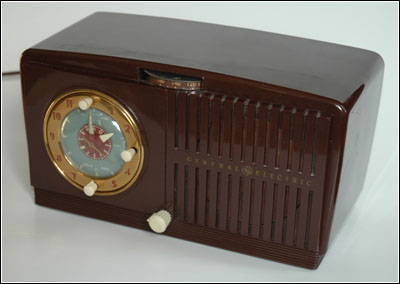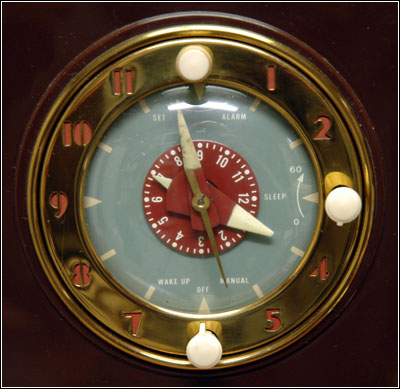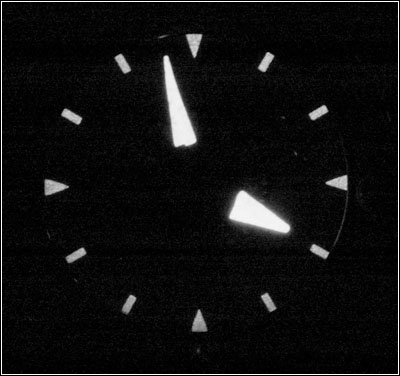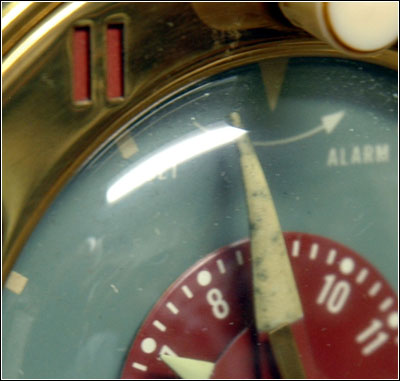Of Old Radios And Related Items--Published Monthly
Glow-in-the-Dark Radios
BY STEVE AUYER
Web Edition
In this article, Steve Auyer wonders about how many of us have thought about the literal meaning of "radioactive" when we joke about our hobby. He points to some interesting facts that give us food-for-thought as we look at our clock radios. (Editor)
I always get a kick out of seeing a radio collector wearing one of those "I'm Radio-Active" badges. Depending upon what they collect, there may be more truth in their badges than they know. Why? Well up until the mid-1970s a number of clocks, including those used in clock radios, used luminescent paint that contained radium!
Figure 1. The GE Model 64 clock radio.Backing up a bit, we need to remember that there are a number of materials that can "store" energy, and then later release it as light. Depending upon the material, the source of the energy may be heat, mechanical deformation, an electric field, visible light, ultraviolet light, etc.
A commonly used material is zinc sulfide, which, after exposure to sunlight, will give off a green glow for several hours. The only problem with using this on clocks is that when you wake up at 3 a.m. and try to read the time, the zinc sulfide has used up its stored energy and is no longer glowing.
However, early in the 20th century, experimenters found that by mixing small quantities of a radioactive material, such as radium in with the zinc sulfide and some sort of binder, they would end up with a paint that would continue to glow "forever." Basically, the radiation released by the radium was continuously recharging the zinc sulfide.
The GE Model 64 Clock Radio
A good example of a clock radio that uses such paint is the General Electric Model 64, which sold in 1950, and is shown in Figure 1. Actually the same basic chassis was used in a whole series of radios: the 64, 65, 500, 501, 505, 506, 507, 509 and 530, with different model numbers indicating different cabinet colors, whether a switched AC outlet was included, and whether a model had a glow-in-the-dark clock.
Figure 2. The clock face of the GE Model 64 in daylight.The clock face of the Model 64 in daylight, shown in Figure 2, is the same clock face in the dark, shown in Figure 3. Figure 3 is a time exposure -- the actual glow isn't quite this bright.
Just because your clock face doesn't appear to glow, doesn't mean that it's not painted with a radium-containing paint. What happens over time is that the glow becomes fainter and fainter. This is not due to the radium decaying, as it has a half life of 1,600 years, but appears to be due to the fact that extended exposure to the radiation damages the zinc sulfide crystals. The result is that they lose their ability to absorb energy and release it as light.
Figure 3. A time exposure of the face of the GE Model 64 in the dark.A tip-off is to take a close look at the hands and markings on the clock, shown in Figure 4. If they appear to be painted with a light greenish/yellowish paint, especially if the coating is a little "lumpy" or discolored in spots, as in Figure 4, you've probably got radium-containing paint.
So, if you have one of these sets, do you need to be worried? The answer is probably not just as long as you are not physically close to the set for many hours every day. It would not be a good idea to have one of these sets on the nightstand by your bed with the clock face a foot from your head!
Figure 4. The hands and markings on this clock are a little lumpy and discolored, indicating the likelihood of radium-containing paint.Use of this radium-containing paint was not limited to clocks. During World War II many controls and instruments used liberal amounts of this paint to provide a strong glow in a darkened cockpit. There have been accounts, possibly anecdotal, of some collectors setting off radiation detectors when they shipped a large quantity of these items at one time.
So to the casual collector, the risk is low but still something to be aware of.
(Steve Auyer, 3925 Cloverdale Circle, Liverpool, NY 13090)
Steve Auyer has been interested in the history of radio since he toured the WLW 500 KW transmitter site in 1963. Lately, his interests have turned to researching and documenting local AM broadcasting history. Since his retirement from Lockheed Martin, he has spent time coordinating the Amateur Radio exhibit at the Museum of Science & Technology in Syracuse, New York.
| [Free Sample] [Books, etc., For Sale] [Subscribe to A.R.C./Renew] [Classified Ads] [Auction Prices] [Event Calendar] [Links] [Home] [Issue Archives] [Book Reviews] [Subscription Information] [A.R.C. FAQ] URL = http://www.antiqueradio.com/Apr07_Auyer_Glow.html Copyright © 1996-2007 by John V. Terrey - For personal use only. Last revised: March 29, 2007. For Customer Assistance please contact ARC@antiqueradio.com or call (866) 371-0512 toll free Pages designed/maintained by Wayward Fluffy Publications
Antique Radio Classified |



